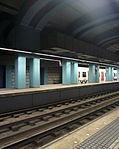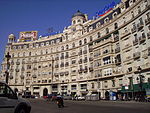Synagogue of Barcelona
20th-century synagogues in SpainAshkenazi Jewish culture in SpainAshkenazi synagoguesMoroccan-Jewish diasporaReligious buildings and structures in Barcelona ... and 6 more
Sephardi Jewish culture in SpainSephardi synagoguesSynagogues completed in 1954Synagogues in SpainTurkish-Jewish diasporaUse mdy dates from September 2024

The Synagogue of Barcelona, officially, the Synagogue of the Jewish Community of Barcelona (Spanish: Sinagoga de la Comunidad Israelita de Barcelona), is a Jewish congregation, synagogue, and cultural center, located at 24 Carrer de l'Avenir, in the city of Barcelona, in Catalonia, Spain. Completed in 1954, the three-story building provides a place of worship with two synagogues, one Sephardic and the other Ashkenazi, and also has a library and a conference room.
Excerpt from the Wikipedia article Synagogue of Barcelona (License: CC BY-SA 3.0, Authors, Images).Synagogue of Barcelona
Carrer de l'Avenir, Barcelona Sarrià - Sant Gervasi
Geographical coordinates (GPS) Address Nearby Places Show on map
Geographical coordinates (GPS)
| Latitude | Longitude |
|---|---|
| N 41.396666666667 ° | E 2.1480555555556 ° |
Address
Comunitat Israelita de Catalunya
Carrer de l'Avenir
08001 Barcelona, Sarrià - Sant Gervasi
Spain
Open on Google Maps









